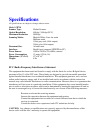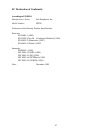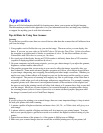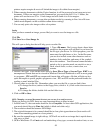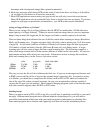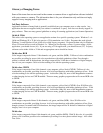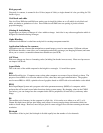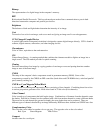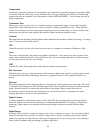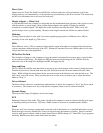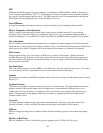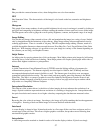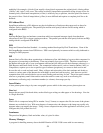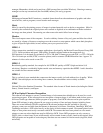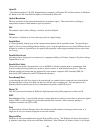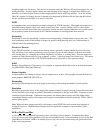54
Compression
Compression means the reduction of data needed to save information, especially image and sound data. There
are lossless methods, which only remove redundant data, and lossy methods, which achieve extremely high
compression rates at acceptable loss of information (such as JPEG and MPEG). A lossy format can alter an
image’s appearance.
Continuous Tone
This process uses dots of any color in a continuous range to represent the image. Contrast this with half-
toning which is the clustering of dots to create an illusion of shading and different colors. Many high end
printers use continuous tone, but most printers and print processes use half-toning. A lower resolution with
continuous tone will allow photo-quality that requires a higher resolution with half-toning.
Contrast
The range between the darkest and the lightest shades determine the number of shades in an image. An image
with low contrast can look dull and flat.
CPU
Central Processing Unit, this is the main processor chip of a computer, for example a Pentium or a 486.
Crop
This term is used primarily with images and graphics applications. If you want to cut away a portion of an
image, such as trimming the sides or top and bottom, you can use an imaging application to Crop the image,
cut away the portions you don’t want to keep.
CRT
Cathode Ray Tube. The picture tube inside computer monitors and televisions.
D/A Converter
Digital/Analog converter, a signal converter which converts a digital input signal to an analog output signal,
for example the image data in the display memory of a graphics board to a video signal the monitor can
display.
Descreen
Most printed material (such as magazine photos) commonly has a moiré pattern across the image. The moiré
is caused by the printing process and will often appear like a dirty screen has been placed across the scanned
image. Descreen removes or reduces the moiré pattern in the image. Many scanners have built in
descreening to remove the moiré effect during the scan. If you have moiré in a completed scan, many
imaging applications also have a descreening feature.
Digital Camera
A camera designed to create digital images, usually with CCD, by converting light into electrical signals
which can then be stored in the camera memory or transferred (downloaded) to a computer. With present
technology, digital cameras are incapable of achieving the higher resolutions possible with film-based
cameras.
Digital Image
An image that is stored in a computer’s memory or in a way a computer can access. You can create a digital
image by scanning an item (picture, document or object) with a scanner, by taking a picture with a digital
camera, by capturing an image with any other type of imagining device, by receiving a fax, or by creating it
directly on the computer using an imaging or graphics application.



